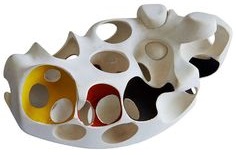Talent is Overrated II
(see
January of 2015 for part I)
In
1964 toward the end of my sophomore year at Occidental, Dean Culley called me
into his office to inform me that my grade point average of 1.2 was nearing a
milestone. Benjamin Culley, who despised me, was the Dean of Men and taught a
course in statistics. He made no effort to mask the pleasure he took in telling me that without a miraculous reversal it would soon be statistically impossible to raise my
GPA to the 2.0 required to graduate. He
added that when I reached this point of no return the college would be obligated
to drop me as a student.
To
avoid losing my student deferment and relocating to either Canada or Viet Nam
 |
| Maquette by Jan de Swart |
 |
| Plaster rasp |
The Hydro-stone process was similar to my water color shenanigans with the toilet plunger. The sculpture had been created with
little or no control on my part and the random or accidental results were far
beyond anything I could have ever done intentionally. The five sculptures I turned in at the end of
the semester looked like I’d spent a hell of a lot more time than the three weeks it
took me. After using a milk crate for the first sculpture, I found containers of different sizes and shapes for the ones that followed. I chose to mount the five finished pieces vertically as excavated towers, the largest of which weighed in at about 90 pounds. Best of all, no one was certain
exactly how I had done it and I wasn’t talking.
 |
| Takach printing press |
 |
| Actually a photo but approximates the visual affect produced by my printing process - image from alternativephotography.com. |
Things
had been going nicely as I was receiving the grades I needed to stay in school
and out of the war. However, I was going
to have to find a way to deal with figure drawing. This was a traditional discipline that hadn’t
yet been contaminated by abstract expressionism. I actually gave it a brief go at first but my attempts were so horrid I retreated into a depressed funk for days. I finally became so desperate that I pleaded successfully with my girlfriend to disrobe and lie down on large sheets of newsprint, where using
her as a template, I tried to draw on the newsprint with a stick of charcoal that
I slid along the contours of her body. It
became quickly obvious that this method was impractical if not
impossible to execute for suffice to say, several reasons.
Fortunately,
this ridiculous experiment led to a solution.
I taped
the paper onto a board, placed it against the wall and used a
lamp to cast the shadow of my girlfriend against the paper. This
was a dramatic improvement as it (1) greatly reduced the level of distraction inherent with the original approach; (2) created enough space between my girlfriend and the paper in which I could work with my back to her; and (3), provided a more stationary guide to trace uninterrupted by flinching.
However the lines I made with the charcoal, as well as pencil or ink, were all terribly shaky and uneven. Having cut countless mat frames as a part-time job, I knew I could execute a better line with a mat knife. I tried using one to cut along the silhouette edge and it worked beautifully. With the tip of the blade slightly buried into the board beneath the newsprint, even if I occasionally hesitated, I was able to cut a line that was consistent, smooth and absent of all the imperfections that came with drawing. I then placed the newsprint on dark paper, spread apart the two halves created by the cut, and created a line of whatever width I desired that was as pure as a laser could have produced had they existed back then.
My
initial idea was to create accurate outlines of the female form from various angles and poses, then fill in
the rest freehand. I was hoping with the proportions of my girlfriend's body outlined correctly, it might not be so difficult to draw in the rest. Then it occurred to me that the lines created
with the shadow cutting were good enough to stand alone. After all, it was often said of Picasso and
Matisse that what they expressed with a single uninterrupted line was the
true measure of their genius. My technique was definitely outside the constraints of the class assignments but I might get away with it if the work was considered unique and I presented it with enough
conviction. With Johnson and Kissinger repeatedly escalating our involvement in Viet Nam, there was no chance I was going to come up short on conviction.
the paper onto a board, placed it against the wall and used a
lamp to cast the shadow of my girlfriend against the paper. This
 |
| Lines lifted from a drawing by Antonia Devine |
However the lines I made with the charcoal, as well as pencil or ink, were all terribly shaky and uneven. Having cut countless mat frames as a part-time job, I knew I could execute a better line with a mat knife. I tried using one to cut along the silhouette edge and it worked beautifully. With the tip of the blade slightly buried into the board beneath the newsprint, even if I occasionally hesitated, I was able to cut a line that was consistent, smooth and absent of all the imperfections that came with drawing. I then placed the newsprint on dark paper, spread apart the two halves created by the cut, and created a line of whatever width I desired that was as pure as a laser could have produced had they existed back then.